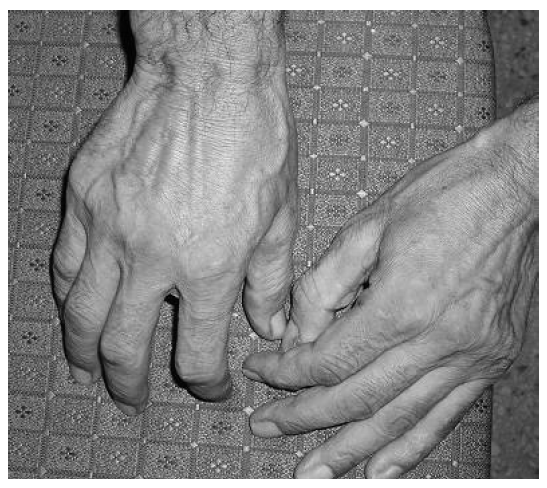Articles
- Page Path
- HOME > J Mov Disord > Volume 4(2); 2011 > Article
-
Case Report
Concomitant Appearance of Pisa Syndrome and Striatal Hand in Parkinson’s Disease - Sanjay Pandey, Manmohan Mehndiratta
-
Journal of Movement Disorders 2011;4(2):78-79.
DOI: https://doi.org/10.14802/jmd.11017
Published online: October 30, 2011
Department of Neurology, GB Pant Hospital, Delhi, India
- Corresponding author: Sanjay Pandey, MD, DM, Department of Neurology, RN. 507, GB Pant Hospital, Delhi, India, Tel +9109868598932, Fax +01123234350, E-mail sanjaysgpgi2002@yahoo.co.kr
• Received: May 24, 2011 • Accepted: August 31, 2011
Copyright © 2011 The Korean Movement Disorder Society
This is an Open Access article distributed under the terms of the Creative Commons Attribution Non-Commercial License (http://creativecommons.org/licenses/by-nc/3.0/) which permits unrestricted non-commercial use, distribution, and reproduction in any medium, provided the original work is properly cited.
- 19,033 Views
- 71 Download
- 5 Crossref
ABSTRACT
- Pisa syndrome is (PS) usually seen in patients receiving antipsychotic drugs and characterised by lateral flexion of trunk and axial dystonia. It is believed that antipsychotic drugs lead to dopamine blockage causing PS. We describe a Parkinson’s disease patient who was doing well with levodopa/carbidopa for 3 years and developed lateral flexion of trunk. His abnormal posture used to completely improve upon lying down position. He also had striatal hand deformity suggestive of focal dystonia.
- A 42 year old gentleman presented with rest tremors, bradykinesia and rigidity for 10 years. He never had any symptoms suggestive of autonomic dysfunctions. On examination there was no cognitive decline and cerebellar signs were absent. He was prescribed levodopa/carbidopa preparation with trihexphenidyl. He responded very well to the treatment [UPDRS scale (off 40, on 24)]. After three years of onset of the disease, family members noticed that while walking he was having lateral flexion of trunk and was leaning on left side (see video). Along with this he also developed striatal hand (Figure 1). During supine position his trunk posture used to improve completely. He also showed significant improvement in symptoms with levodopa/carbidopa. His abnormal posture was worse during ‘off’ period in comparison to ‘on’ period. He was never given any typical or atypical neuroleptic agents. X-rays whole spine, MRI brain and paraspinal electromyography (EMG) were normal.
Case
- This patient of PD was diagnosed to have Pisa syndrome due to lateral flexion and axial dystonia on standing which used to completely improve in supine position. Normal EMG and spine X-rays rule out any other possibilities.
- Pisa syndrome is a combination of lateral deviation of spine and corresponding tendency to lean on one side.3 Exact pathogenesis of PS is still not known. Different hypothesis have been discussed for understanding the mechanism of this syndrome. It is believed that cholinergic excess in patients of AD receiving cholinesterase inhibitor cause PS. In patients of PD it may be possible that striatal dopamine deficiency or imbalance in dopaminergic-cholinergic level is responsible for PS.4 This imbalance seems to be asymmetrical and is responsible for the lateral flexion on one side. Some authors have described improvement in this phenomenon following levodopa/carbidopa treatment. Our patient also had significant improvement in lateral flexion on standing during on period, however striatal hand symptoms showed no response to levodopa/carbidopa. It has been described that PD subjects in advanced stage of disease (HY III & IV) have more postural abnormality and striatal deformities while our patient manifested in early part of disease (HY IIb).3 Dopa agonists and amantidine has been tried with variable response. Neurosurgical interventions like pallidotomy and deep brain stimulation has also been tried in 13 subjects with good results.5
Discussion
- 1. Ashour R, Tintner R, Jankovic J. Striatal deformities of the hand and foot in Parkinson’s disease. Lancet Neurol 2005;4:423–431.ArticlePubMed
- 2. Patel S, Tariot PN, Hamill RW. Pisa syndrome without neuroleptic exposure in a patient with dementia of the Alzheimer type. J Geriatr Psychiatry Neurol 1991;4:48–51.ArticlePubMed
- 3. Cannas A, Solla P, Floris G, Tacconi P, Serra A, Piga M, et al. Reversible Pisa syndrome in patients with Parkinson’s disease on dopaminergic therapy. J Neurol 2009;256:390–395.ArticlePubMed
- 4. Villarejo A, Camacho A, García-Ramos R, Moreno T, Penas M, Juntas R, et al. Cholinergic-dopaminergic imbalance in Pisa syndrome. Clin Neuropharmacol 2003;26:119–121.ArticlePubMed
- 5. Umemura A, Oka Y, Ohkita K, Yamawaki T, Yamada K. Effect of sub-thalamic deep brain stimulation on postural abnormality in Parkinson disease. J Neurosurg 2010;112:1283–1288.ArticlePubMed
REFERENCES
Figure & Data
References
Citations
Citations to this article as recorded by 

- Pisa syndrome in dementia with Lewy bodies: A Chinese multicenter study
Zhou Su, Shuai Liu, Gang Chen, Jinghuan Gan, Xinran Bao, Hongcan Zhu, Xiaodan Wang, Hao Wu, Yong Ji
Parkinsonism & Related Disorders.2022; 103: 50. CrossRef - Striatal hand in an elderly man with disseminated tuberculosis: An unusual first case
Rohit Gaude, Upinder Kaur, Ishan Kumar, Deepak K Gautam, Indrajeet S Gambhir, Sankha S Chakrabarti
Geriatrics & Gerontology International.2018; 18(8): 1300. CrossRef - Frequency and clinical correlates of postural and striatal deformities in Parkinson’s disease
Amin Cervantes-Arriaga, Mayela Rodríguez-Violante, Hugo Morales-Briceño, Gabriel Neri-Nani, Roxanna Millán-Cepeda, Salvador Velázquez-Osuna
Clinical Neurology and Neurosurgery.2016; 142: 140. CrossRef - Pisa syndrome in Parkinson's disease: An integrated approach from pathophysiology to management
Michele Tinazzi, Christian Geroin, Marialuisa Gandolfi, Nicola Smania, Stefano Tamburin, Francesca Morgante, Alfonso Fasano
Movement Disorders.2016; 31(12): 1785. CrossRef - Reversible Parkinsonism and Pisa Syndrome in Juvenile Normal Pressure Hydrocephalus
Sanjay Pandey
Movement Disorders Clinical Practice.2015; 2(1): 72. CrossRef
Comments on this article
 KMDS
KMDS
 E-submission
E-submission

 PubReader
PubReader ePub Link
ePub Link Cite
Cite

